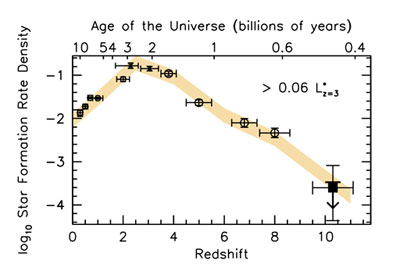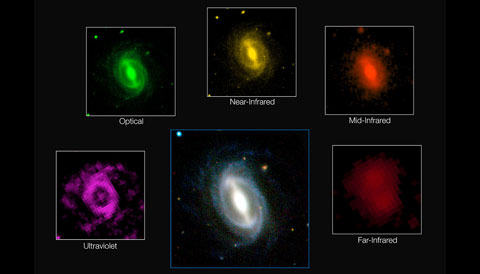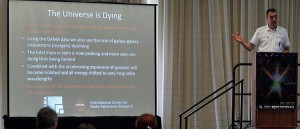Recent headlines proclaim that the universe is dying, but we’ve actually known that for decades. Here’s what’s really interesting about recent research on the nearby universe.
Major news organizations are covering a recent study with a dramatic press release title: “Charting the Slow Death of the Universe.” That sure caught my attention, too. But as I read the release, I realized the researchers were simply studying the well-known downward turn in starbirth across the cosmos.

Bouwens
Astronomers have known for decades that star formation peaked when the universe was less than half its current age, roughly 3.5 billion years after the Big Bang. Since then, galaxies have pumped out fewer and fewer stars, in a steady decline. Not surprisingly, galaxy growth has followed the same evolutionary trend — galaxies build themselves up in part by forming stars — and perhaps more surprisingly, so has the growth of supermassive black holes found at galaxy centers.
So what’s the big deal with this new study? Part of it is the sheer immensity of the sample size. Simon Driver (The University of Western Australia and University of St. Andrews, UK) and colleagues have combined data from three space missions and two ground-based facilities into a truly massive data set called the Galaxy and Mass Assembly survey (GAMA). The result is a panchromatic view of 221,373 galaxies, covering radiation emitted at wavelengths between the far-infrared (500 microns) and the far-ultraviolet (0.1 microns).

ICRAR / GAMA and ESO
Traditionally, logistics have limited galaxy surveys in wavelength range — it’s simply difficult to mesh together the different resolutions, sensitivities, and data streams that come from different facilities. Radio surveys would only glimpse neutral hydrogen gas reservoirs, for example, and see nothing of the stars forming from those reservoirs. The result was a bit like the blind men touching the elephant.
With full coverage over the ultraviolet-visible-infrared range, this survey sees not only stars’ ultraviolet light, but also the indirect light generated when intervening dust intercepts UV photons, heats up, and re-radiates the energy at infrared wavelengths.
And yes, this survey sees with unprecedented precision that the universe is dying. Divvying 138,000 galaxies into three cosmic timeframes, Driver’s team sees that the in the most recent cosmic era, the universe’s energy production (as radiated at wavelengths from far-UV through far-IR) has fallen almost 50% over a period of 1.5 billion years. As the authors write in their paper, submitted to Monthly Notices of the Royal Astronomical Society, this result is expected and completely in line with previous studies of the starbirth rate in our nearby universe.

Babak Tafreshi
The study also found that the rate at which galaxies interact (whether full-scale collisions or minor disruptions during close passages) is also decreasing over time. Since mergers and close passes inspire star formation, this is one of the factors in its decline.
(No worries, though — low-mass stars, those with the longest lifespans, will continue to shine hundreds of billions of years from now. It will be a long, long time before the universe goes completely dark.)
What the survey also reveals is that, even as the universe’s overall energy output declines, the share put out at ultraviolet wavelengths increases. In other words, as cosmic time moves on, less and less dust pervades the universe, so those ultraviolet photons (most of them from stars) move more freely. This effect is surprisingly important given that the typical galaxy has less than 1% dust by mass.
Less dust over time is somewhat surprising, since it's at the end of stars' lifecycles when most dust is produced: in aging stars' winds and in supernova explosions. But dust is also destroyed by the UV photons that stars produce both at the beginning and end of their lives, says Driver.
"The fact that old elliptical galaxies contain almost no dust suggests that ultimately the destruction phase wins," he adds. "A lot of people are working hard on dust formation and destruction models and there’s quite a few puzzles."
It’s this kind of “side” result that, even if it doesn’t generate cool headlines, will ultimately prove this survey’s power. And you can be a part of it, too — the GAMA team is calling citizen scientists to classify GAMA galaxies in a project Galaxy Explorer. It's nice to know that we can all still participate in studying this immense, dying universe of ours!
Babak A. Tafreshi, S&T contributing photographer, contributed to the reporting for this article.
 7
7
Comments
Peter Wilson
August 12, 2015 at 11:56 am
Are cosmologists intentionally trying to make the subject difficult?
They report star formation density, that is, per unit volume of space, whereas the volume of space is constantly increasing. In other words, according to the graph, the number of stars born per-cubic-parsec peaked some 3.5 billion years ago, at about 10 times what it is today, but there are now about 10 times as many cubic parsecs as there were then. So is the actual rate about the same? Or gone down just a little? It's impossible to tell from the graph.
The amount of mass in the universe is approximately constant, and what's measured is brightness, so the natural way to express the phenomenon is watts-per-kilogram, or w/kg. Like the wattage of a light-bulb, w/kg gives an immediate measure of how bright the universe is or was.
With so much confusion in cosmology today, especially regarding dark matter and dark energy, cosmologists should not confound the situation with convoluted measures that people only think they understand. Keep it simple. Use SI units. The phenomenon is one of brightness; what's measured is brightness; do not express it as something else. Express the universe’s brightness in units of brightness: w/kg.
You must be logged in to post a comment.
Monica YoungPost Author
August 12, 2015 at 3:13 pm
Hi Peter, These star formation rate densities are calculated in terms of "comoving volume," which basically means that the universe's expansion has been taken into account.
You must be logged in to post a comment.
Dave
August 14, 2015 at 9:08 pm
"The study also found that the rate at which galaxies interact...is also decreasing over time.
Well, yeah, but if the universe is expanding then this should be expected, no?
You must be logged in to post a comment.
Dave
August 14, 2015 at 9:12 pm
Oops, I guess I should've read Peter Wilson's comment first.
You must be logged in to post a comment.
Peter Wilson
August 16, 2015 at 11:34 pm
Thanks, Monica. So it’s like a toll-way that charges per space instead of per vehicle?
I bring it up because there is a mystery afloat with respect to dark energy, and we need some clarity. First off, “star formation rate density” is just a fancy term for the rate-of-contraction. Secondly, we have to stop treating expansion and contraction as two different subjects.The universe is doing both at the same time. It is “dualistic;” expanding and contracting. Like the counter-weight going down while an elevator goes up, parts of the universe contract while others expand. Stars and galaxies lose energy, while remote regions gain energy. Expansion and contraction have the same dimensions, power per unit mass, because they are flip-sides of the same coin.
Presently, however, “star formation people” express the contraction-rate as star-formation-rate-density, while “expansionists” express the opposite as kg/kg, as in 3 kg dark energy per kg of matter. Obviously, it is impossible to compare star-formation-rate-density with kg/kg.
The picture will become clearer when we use the same units for contraction and expansion, e.g. w/kg, and can compare one to the other. So why not?
You must be logged in to post a comment.
Spinoza
August 18, 2015 at 9:28 am
time begotten and death destined. we are such a pin prick in time. marvel and perish earthlings.
You must be logged in to post a comment.
Jacques Millet
August 18, 2015 at 10:34 am
Dark energy seems to be a force pushing matter outward and accelerating the universe expansion. What if gravity were just the same? Newton imagined that bodies attract each other. Maybe it's dark energy that is pushing masses towards each other. I think the laws of Newton would still be valid.
You must be logged in to post a comment.
You must be logged in to post a comment.